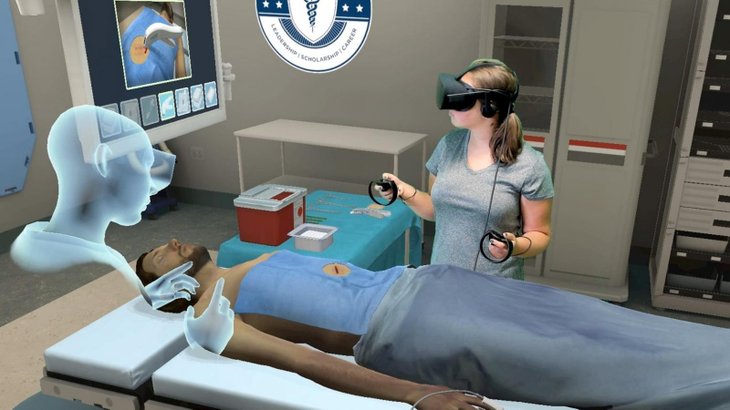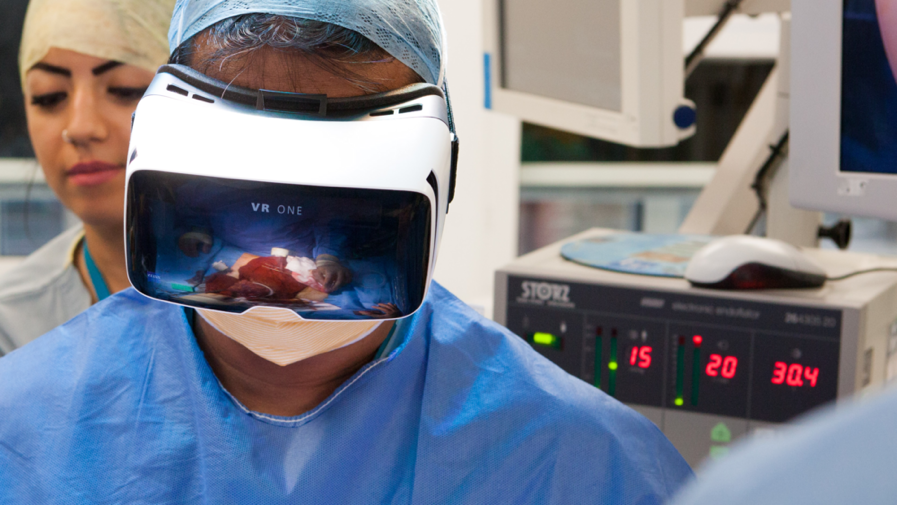Virtual Reality in Healthcare: From Training to Treatment

Virtual Reality in Healthcare is a technology that is transforming the healthcare industry in ways that were once unimaginable. The use of Virtual Reality (VR) in healthcare is changing the way healthcare providers treat their patients, how medical students learn, and how medical professionals conduct research. In this post, we will explore 5 different ways in which VR is transforming the healthcare industry.
Virtual Reality in Medicine: 5 Ways Medical VR Transforms Healthcare
The use of VR in medicine is transforming the way healthcare professionals diagnose and treat their patients. Here are 5 ways VR is transforming the healthcare industry:
1. Medical Training
Medical students can now simulate surgeries and other medical procedures in a safe and controlled environment using VR. VR simulations can help these students learn anatomy, surgical procedures, and other medical techniques in a way that is both efficient and effective. These VR simulations allow for a hands-on learning experience without the risk of harming a patient.

2. Patient Therapy and Rehabilitation
VR can be used to create a virtual environment that can be used for physical and psychological therapy. Patients dealing with physical or psychological conditions can be put into a VR environment where they will be able to receive treatment without actually traveling to a specific location. This can be particularly beneficial for patients who are unable to travel, or for those who require intense rehabilitation.
3. Diagnosis and Treatment of Mental Health Conditions
VR can also be used in the diagnosis and treatment of mental health conditions such as anxiety disorders and post-traumatic stress disorder (PTSD). Patients can be exposed to virtual environments that replicate real-life situations that may trigger their symptoms. Exposure to these situations can help patients develop coping mechanisms and better understand their conditions.

4. Pain Management
VR can be used to distract patients from unpleasant procedures or to manage chronic pain. Patients can be immersed in a VR environment where they can focus on the virtual environment rather than the physical sensations they are experiencing, allowing them to better tolerate the pain.

5. Surgical Planning
Surgeons can use VR to plan out surgeries and to practice their techniques before performing them on patients. These simulations allow surgeons to identify any potential problems or complications that could occur during the surgery and to develop strategies to address them.

Abstract
Virtual Reality is transforming the healthcare industry in numerous ways. From medical training to patient therapy and rehabilitation, VR is making healthcare more efficient, effective, and accessible. By offering a hands-on learning experience, VR simulations are helping medical students learn anatomy, surgical procedures, and other medical techniques in a risk-free environment. Additionally, patients dealing with physical or psychological conditions can receive treatment through VR environments, rather than requiring physical travel. VR is also being used in the diagnosis and treatment of mental health conditions, as well as for pain management and surgical planning. The use of VR in healthcare is revolutionizing the industry in countless ways.
Introduction
Virtual Reality has been around for several decades, but it is only in recent years that it has gained significant attention in the healthcare industry. The use of VR in medicine is transforming the way that healthcare professionals diagnose and treat their patients. This technology is revolutionizing medical training, patient therapy, and rehabilitation.
Content
1. Medical Training
VR is revolutionizing medical training by offering students a hands-on learning experience. Medical students can now simulate surgeries and other medical procedures in a safe and controlled environment. By providing a realistic environment to practice in, VR simulations can help these students learn anatomy, surgical procedures, and other medical techniques in an efficient and effective way.
Medical students are no longer required to rely on theoretical models or cadavers to learn medical techniques. VR simulations are becoming an essential part of medical training. These simulations allow students to practice procedures as many times as necessary, without the risk of harming a patient. Medical schools are investing in VR training facilities, recognizing the importance of this technology in medical education.
2. Patient Therapy and Rehabilitation
VR can also be used to create virtual environments that can be used for physical and psychological therapy. Patients dealing with physical or psychological conditions can be put into a VR environment where they will be able to receive treatment without actually traveling to a specific location. This can be particularly beneficial for patients who are unable to travel
VR therapy sessions can be more efficient and effective than traditional therapy. Patients can be placed in environments that they may not have access to in real life, such as specific destinations or even space. This can help them overcome their mental or physical limitations and provide new, positive experiences.
3. Diagnosis and Treatment of Mental Health Conditions
VR can also be used in the diagnosis and treatment of mental health conditions such as anxiety disorders and post-traumatic stress disorder (PTSD). Patients can be exposed to virtual environments that replicate real-life situations that may trigger their symptoms. For example, a patient suffering from anxiety can be placed in a virtual simulation of a crowded public space, allowing them to practice and develop coping mechanisms, providing them with the means to overcome their fears.
Virtual therapy for these conditions can be more efficient, cost-effective, and less intrusive than traditional therapies. VR provides the means for patients to receive the same level of therapy and treatment without having to leave their home.
4. Pain Management
VR can also be used for pain management. Patients can be immersed in a VR environment where they can focus on the virtual environment rather than the physical sensations they are experiencing, allowing them to better tolerate the pain. This technology can be particularly beneficial for patients who experience anxiety or fear associated with medical procedures.
VR technology provides a distraction for the patient, diverting their attention from the pain or procedure being undertaken. This technology could potentially reduce the need for pain medication and other narcotics, providing patients with an alternative means of managing pain.
5. Surgical Planning
Surgeons can use VR to plan out surgeries and practice their techniques before performing the operation on patients. These simulations allow surgeons to identify any potential problems or complications that could occur during the surgery and to develop strategies to address them.
Using VR technology for surgical planning can reduce the possibility of human error during the surgery, providing patients with safer surgeries and better outcomes. Surgeons can run multiple simulations to perfect their surgical technique, resulting in better patient outcomes.
Conclusion
Virtual Reality is transforming the healthcare industry in countless ways. From medical training to pain management and surgical planning, VR is revolutionizing the industry by offering new, innovative solutions to existing medical problems. By providing a hands-on learning experience, VR simulations are helping medical students develop the skills they need to become successful healthcare professionals. VR technologies are also benefiting patients by providing them access to virtual therapy sessions and creating a safe, less invasive environment for pain management. The future opportunities for Virtual Reality in healthcare are vast, offering healthcare professionals new and better ways to help and treat their patients.
Source image : www.bloglovin.com

Source image : mobygeek.com

Source image : visualise.com

Source image : unimersiv.com

Source image : immersivegaze.com





